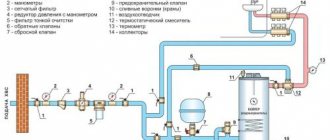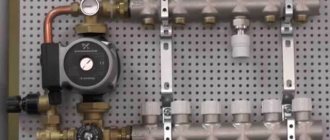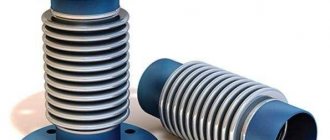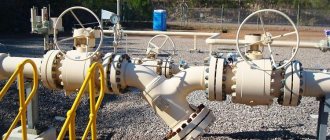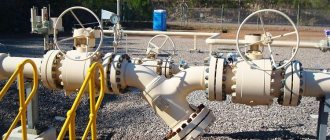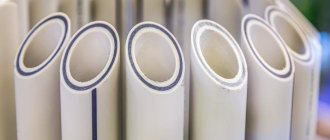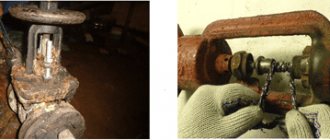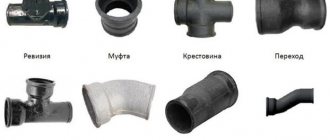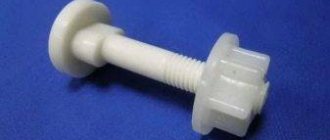Shut-off and control valves are an integral device that is actively used in all areas of activity to strengthen pipeline systems and reinforcement. Used as a locking element. Not in all cases it occupies the full cross-section of pipes. It is only necessary to ensure sufficient fastening of the device. It combines several functions at once - shut-off and regulating, which provides more functionality when used.
Without the use of shut-off valves, it is impossible to imagine the operation of most modern pipe parts. Some areas of the systems require redirection of the flow of working fluid, so reinforcing fittings can be used in the complex.
What types of shut-off and control valves are there?
Shut-off valves are special elements that are used to control pressure and other parameters of the pipeline environment. Such parts are installed for oil pipeline, sewerage, water supply and heating systems. It can be installed both on large main lines and to meet individual needs in production.
There are various indicators that need to be constantly monitored. In order not to turn off all equipment, shut-off control valves are used. There are several different types of shut-off valves depending on the working environment:
- To shut off gas or liquid. A valve is placed on the pipe, which has only two positions: on or off. Depending on this, the substance moves or remains in one place.
- For adjustment. Designed to set the required characteristics of the working environment. Not used to completely block the flow.
- Combining several parameters. The switch can be set to different positions, which provides greater flexibility.
Shut-off and control valves are a device that has several characteristics. In turn, it is classified as follows:
- Seat valves. Used in systems where it is necessary to control the working environment under high pressure. Designed for large highways. The power part is performed by the piston.
- Ball equipment. In the inner part there is a spherical part. It is placed perpendicular to the pipes, which allows you to partially block the flow of gas or liquid.
- Wedge-shaped reinforcement. A wedge is placed inside. Depending on the position, it opens or closes the passage of the working fluid.
- Rotary disc devices. The regulator looks like a disk. If it is turned up, liquid or gas passes through. Otherwise, there is no passage. The adjustment occurs depending on the intermediate state setting.
Types of control valves
- Photo-separation – used when it is necessary to separate working media that are in different states.
- Condensation – used to eliminate condensation, limited passage or blocking of superheated steam flows.
- Protective shut-off and control valves are aimed at automatically protecting pipelines and equipment from unforeseen or unacceptable changes in the functioning of the pipeline system.
- Control room – designed to control the flow of working media into measuring and control devices.
- Mixing and distribution - distributes separate flows of working media in various directions or is directly involved when it is necessary to mix them.
- Throttling - used when it is necessary to reduce the pressure of working media in systems that operate under conditions of significant sudden pressure drops.
- Non-return valve is a check valve in which forced opening, restriction or closing of the stroke is possible.
Purpose of shut-off and control valves
Shut-off and shut-off and control valves are actively used in various fields of activity. Such elements of the piping system are used to regulate certain parameters.
Such elements are manufactured to ensure regulation and redirection of the main flow of the working environment. Typically, such a device can be seen in an area where the system is divided into several directions. Depending on the requirements, one stream is opened and the other is closed. This is used for repair work, which allows you not to turn off the entire system, but only part of it.
Pipeline control valves
Pipeline control valves are valves designed to regulate the parameters of the working environment by changing the flow rate of the medium through its flow area.
It is divided into pressure-reducing valves - designed to reduce the operating pressure in the system, and shut-off and control valves. Control valves can be manually or automatically controlled using electric drives.
Types of control valves:
- The control valve is the most common type of control valve. Valves are divided into straight valves - installed on straight sections of the pipeline, do not change the direction of flow, angular - change the direction of flow by ninety degrees, and three-way, or mixing - have three pipes for connection to the pipeline, and mix two flows into one. Electric actuators, electromagnetic actuators and pneumatic actuators are used to control control valves.
- Shut-off and control valve - With the help of this valve, both regulation according to a given characteristic is carried out, and the valve is sealed according to the tightness standards for shut-off valves, which is ensured by a special design of the plunger, which has a profile part for regulation, as well as a sealing surface for tight contact with the seat in position "closed".
- Mixing valves - Used when it is necessary to mix different media, keeping some parameter constant. The difference between mixing valves and control valves is that the control action determines the flow rates of two media simultaneously, and not just one.
- Direct-acting pressure regulators are used where it is necessary to maintain constant pressure in the pipeline. Pressure regulation can be carried out after the regulator (in the direction of the medium flow), in which case the regulator is called “After itself,” or in front of it, in which case it is called “Before itself.”
- Level regulator -Level regulators are used in vessels used in power, refrigeration and other installations. They are controlled by a float, upon command from which the required amount of liquid is introduced or excess liquid is released.
Shut-off and control valves - characteristics and purpose
An important indicator of shut-off valves for water supply is throughput. This is the main characteristic that determines the selection of other parameters. Bandwidth is divided into several other types that allow you to fully describe the operation of the system.
Relative leakage is one of the main indicators that allows you to determine leaky sections of pipes, as well as the likelihood of a possible leakage of a substance. The control valves must provide the required level of tightness. In some cases, other indicators are determined to assess the quality of the system.
Main parameters of control valves
The structural element allows you to adjust the following indicators:
- temperature regime of the functioning of the environment;
- distribution of the substance within the pipeline system;
- different types of pressure in the system;
- compliance with the correct distribution of substances and proportions in the working environment;
- maintaining fluid at the same level.
It does not matter what brand of parts will be installed. They are identical in structure, so they are completely suitable for different characteristics.
Types of shut-off and control valves
There are several different types of shutoff valves. The classification depends on the functional features of the device. The following types of devices are distinguished:
- Constipation. Required to completely shut off the operating current. Most often used to equip heating and plumbing systems.
- Regulatory. Used to control the basic characteristics of the system. Allows you to adjust pressure, temperature, concentration and other indicators.
- Shut-off and regulating. A multifunctional device that blocks or regulates the main flow.
- Emergency. Eliminates possible consequences of system failure. Protects other areas from the spread of the problem.
- Safety. The design is triggered in the event of an accident. Otherwise not used.
- Mixing. Allows optimal distribution and direction of working fluids. Installed in heating systems to ensure the required temperature conditions.
- Phase separating. Distributes the work environment by functionality.
Characteristics and purpose
Shut-off and control valves are devices that are designed to shut off, change and control the parameters of the internal environment of a pipeline. Such fittings are installed in water supply, heating, sewerage and gas supply systems.
The devices are used at all levels: from large highways to individual pipelines located inside a house or apartment.
Each system has several parameters that can be adjusted. These include volume and flow rate, pressure, temperature. Shut-off and control valves are used to allow these parameters to be changed without shutting down the system.
The purpose of such parts is to redirect the flow of liquid or gas to other branches of the system. To do this, the device is installed in a place where there are branches. As necessary, some branches are closed and others are opened.
Other types of shut-off and control valves are capable of reducing the pressure inside the system if it increases or decreases the temperature. Some of them work automatically, according to the laws of physics.
For example, a release valve allows gas to flow only when the pressure inside the system increases. This allows you to keep this parameter at the same level. Other devices are manually adjusted, for example using valves.
The main characteristic of shut-off and control valves is its throughput. For optimal application, relative, actual, maximum, initial and conditional throughputs are calculated.
Note! Throughput is a physical quantity that reflects the volume of a medium of constant density passing per unit time through a cross-section of a pipe at a pressure of 1 bar. Simply put, it is the amount of liquid or gas that can pass through a pipe in a certain period of time.
In addition, shut-off and control valves are characterized by the range and zone of regulation, as well as the setting of the regulator. These parameters reflect the differences between the maximum and minimum throughput data: the range of values that can be adjusted.
We recommend that you read: Functional and design differences between a valve and a gate valve
Another important characteristic is relative leakage. It reflects the theoretical ability of parts to deviate from the specified tightness parameters. Simply put, this is a quantitative reflection of the leakage of the product.
Requirements for shut-off valves
Control valves for pipelines must meet certain requirements:
- Accuracy. The system may only be used under the specified conditions. Otherwise, problems may occur. The device will quickly become unusable.
- Strength. Equipment must be made from quality parts. This guarantees reliability for many years.
- Sustainability. Resistance to high or low temperatures is important. For use in extreme conditions, chemical resistance is important.
- Tightness. Pipes are manufactured in such a way as to avoid leakage of liquid and ensure its flow through the pipes.
- Long service life. The service life varies depending on the materials used. The most wear-resistant materials should be selected to ensure a long service life.
- Easy to use. It is necessary to maintain the system in optimal condition so that it lasts as long as possible.
If you choose the right shut-off valves for your water supply, it will last about thirty years. When selecting a suitable device, the parameters listed above should be observed.
DIY installation of shut-off and control valves
Here we will talk about how to install automatic regulators with your own hands when installing radiators. This work requires some skills, but is quite accessible to a novice home craftsman.
Required tools and equipment
No special tools are required to install thermal heads. You will need: a pair of adjustable wrenches, FUM tape (gaskets are included with the thermostat), and the thermostat itself.
To solder MRN you will need: scissors for cutting plastic pipes, a device for soldering plastic pipes and fittings - MRN, 90° angle...
Installation procedure
Installation procedure:
- Drain the water from the radiator and disconnect it from the system. If you have a single-pipe heating system and radiator connections and the work is carried out during the heating season, then you should install a bypass;
- the thermostat is screwed into the plug through which coolant is supplied to the radiator and replaces the tap for connecting the battery;
- the arrow on the regulator body must coincide with the direction of water flow in the heating system;
- the radiator is installed in place - instead of a tap to connect the battery, it is necessary to solder the MRN and an angle (bend) to the heating system;
- the radiator is filled with water, checked for leaks, air is bleed through the Mayevsky tap;
- The thermostat is being adjusted.
Shut-off and control devices for heating systems
Shut-off and control valves for heating are manufactured specifically for operation at elevated temperatures. Made from materials that allow you to work in high temperature conditions. Most often, such pipes include bronze or stainless steel. Depending on the heating systems, different devices can be installed.
Shut-off valves for heating are used for different purposes:
- Branches on pipes. Allows you to shut off the line or redirect the flow of working fluid if necessary.
- Mayevsky crane. Ball valve. Designed to remove excess air and reduce pressure in the system.
- Check valves. They provide the opportunity to direct the flow in the right direction to reduce the likelihood of breakthroughs.
- Faucets. Mix hot and cold streams.
Shut-off valve
Such a valve is also a shut-off valve and is widely used. As for its principle of operation, it is similar to valves and taps, that is, it allows you to regulate the flow of the coolant medium. Often the working medium is water. The valve makes it possible to change the pressure and flow of liquid. In the case of hot water, shut-off and control valves made of steel are usually used. Much less common are metal-plastic products.
Like other fittings, shut-off and control valves come in several types. Thus, manual ones are relevant in cases where it is necessary to block the environment partially or completely. In other situations, valves equipped with the following actuators are in great demand:
- Electromagnetic;
- Electric;
- Hydraulic;
- Pneumatic.
Valves with electric drive are the most widespread, because they do not require the laying of special lines and the installation of compressors.
The main task of any pipeline fittings is to be leak-tight, so various methods can be used to connect to pipelines, depending on what operating pressure is expected. One of the methods is a fitting method, but if the pressure is high, it is better to use the flange, coupling or welded method. Steel shut-off and control valves are connected only by welding.
The value of control pipeline fittings
Control valves for heating radiators have found extensive use. These devices are the most popular on the market as they provide all the necessary functions.
Parameter adjustment is a necessary step in the management and control of technological processes. It is quite difficult to adjust the parameters of the speed and pressure of the working medium. Without the use of regulators, it is impossible to ensure the necessary accuracy of system operation and fluid supply. When control equipment operates correctly, the functioning of systems in other industries is greatly simplified.
Where is RA used?
Ensures normal and safe operation of utility networks with working media - control valves . It is not always subject to the requirement of tightness. The device is selected according to the main criteria:
- throughput characteristics;
- relative leakage.
Control valves serve to maintain the normal flow of the working medium, safe operation of equipment and economical consumption of resources. When installing them, you must consider:
- Changes in pressure and temperature of the medium in the line.
- Strength specifications.
- Necessary regulatory indicators.
Based on the type of problems being solved, installation areas for control valves of this type are determined.
Shut-off and control valves
Combined systems make it possible not only to shut off the flow of working fluids, but also to regulate them. In this case, it is possible to ensure the required level of tightness and a full range of control settings. Shut-off and control valves make it possible not to shut off and regulate currents, which is successfully used to provide heating systems.
Such systems allow you to adjust heating parameters. It is possible to turn on or off the energy supply in certain areas of the circuit, which makes heat supply simpler, more efficient and safer. This technology is used in various industries.
Pipeline accessories
Shut-off valves for radiators have found wide application in various industries. It allows you to block or open access to the working environment to move through the pipeline system. It is used to supply water pipelines, gas pipelines and other systems. It is impossible to imagine the functioning of most modern equipment.
The pipeline device must have high strength, reliability, and tightness. Installation of the structure does not take much time. High-quality material will last a long time without losing its original qualities.
Shut-off valves
Shut-off valves are designed to block the flow of the working medium with varying degrees of tightness. Therefore, tightness and tightness life serve as basic indicators of the functionality and quality of shut-off pipeline valves.
Shut-off valves have two positions - “open” and “closed” . An intermediate position of the working body may not be provided.
Shut-off valves also include:
- Shut-off valves are valves with a minimum response time, determined by the requirements of the technological process.
- Discharge (drainage) fittings - designed for discharging the working environment from containers (reservoirs) and pipeline systems.
- Control valves - designed to control the flow of working fluid into control and measuring equipment and instruments.
Basic designs of shut-off valves:
- Valves (ball, plug)
- Valves
- Valves
- Butterfly valves
Types of shut-off valves by area of application
Depending on the area of use, shut-off valves are divided into the following types:
- Industrial. Intended for use in various fields of activity. Provides heating, water supply and other communications.
- General. Used in areas where special attention is paid to temperature, pressure, exposure to aggressive chemicals and other extreme influences.
- Special. Manufactured according to special patterns to order. Customized technical requirements are provided.
- Ship's. Used on ships. The parameters of rigidity, vibration, resistance to water and others are taken into account.
- Plumbing. Used in many areas for: shower connections, faucets, home plumbing. It is equipped with elements that allow you to install the system manually without the use of special tools.
- Special Order. Manufactured for enterprises with special operating conditions.
Types of fittings on pipelines
The term “valve type” refers to its functions, the main ones being:
- constipation,
- regulation,
- prevention,
- obstacle to reverse movement,
- stream separation.
Shut-off valves (on-off, shut-off, stop) are technical devices that perform the function of hermetically shutting off the flow of the transported working fluid.
In addition to the main locking type, in the technical industry there are the following types of combined or multifunctional (combined, multifunction), combining different functions of fittings:
Shut-off and control (on-off and control) - in addition to completely blocking the flow, shut-off control valves for heating, water supply and other needs are capable of changing the volume of a moving medium by partially blocking the channel passage.
Stop and check - in addition to blocking the channel passage, it prevents the passage of the medium in the opposite direction.
Non-return shut-off (stop non-return) - in addition to preventing flow movement in the opposite direction, it implements the function of forced closing or limiting the movement of the shutter element.
Rice. 3 Sectional design of shut-off valves
Type of fittings by type of connection to the system
Reinforcement is distributed according to many characteristics. The method of fastening is important. This takes into account the type of thread of the product, the required tightness, and more.
Threaded connection
Mainly used for large pipes. The thread diameter is always indicated on the equipment. The connection can be attached using a thread spanner. To enhance the tightness of the system, various substances can be used. Typically used for valves, distributors, gate valves.
Among the advantages, it should be noted the ease of installation and the relative low cost of the technology. Disadvantage: inability to use in pipelines with high pressure.
Union connection
Used for thin pipes. The thread is on the outside. This type of connection allows you to connect measuring instruments. Used in specific conditions.
Welded joint
Welding is used in cases where liquid hazardous to health flows through pipes. It is necessary to ensure a high degree of tightness of the system. The seam should be strong enough to reduce the chance of leakage.
The following welding methods are distinguished:
- the coupling point is additionally secured with a ring;
- the seam is made from the outside.
This work allows us to ensure the required degree of tightness of the system. Before installation, it is necessary to process the ends of the pipes. The fastening method is characterized by low cost and ease of execution. Installation of the structure requires specialists.
Shut-off valves for toilet flush barrel
It is the use of special sealed elements that ensure the functioning of the drain barrel. The strength and reliability of the plumbing fixtures depends on the reliability of the fastening.
Types of shut-off valves based on valve design
Pipeline fittings of different types differ in the design of their actuating units (gates), which ensure the closure of the pipeline passage channel. Also, the design of the locking mechanism in many cases determines the overall dimensions and area of use of the injection molding machine.
Valves
A valve is a type of injection molding machine whose shut-off or adjusting element moves at an angle of 90 degrees relative to the transported flow.
Blocking flow movement using valves is one of the most commonly used methods in the industrial and utility industries; they are usually used on pipelines with a diameter of 50 mm and above. GOST 24856-2014 regulates the following types of valves:
- Wedge gates are devices with a moving gate shaped like a wedge. When lowered, it rests on the surfaces of the seat rings, placed between each other at a similar angle. For example, a cast iron valve with a rubber-coated wedge 30h39r.
- Parallel gates - have saddle seals placed mutually parallel.
- With a retractable spindle, rod (gate valve with rising stem) - when opening or closing the passage channel, the rotating spindle or rod on which the lock is attached moves relative to the central axis of the connecting taps by the length of the working stroke.
- With a non-rising spindle (gate valve with non-rising stem) - when opening and closing the passage channel, the rotating spindle does not move in a forward direction relative to the central axis of the device, and its threaded section does not extend beyond the internal body area.
Rice. 12 Wedge-shaped valve - a structural device using the example of model 30s41nzh
- Gate or knife (slide gate, slab gate) - the gate element is a plate with a parallel arrangement of seat rings. (You can learn about gate valves in a separate article).
- wedge gate - the locking element is made of two inclined discs. In their placement, the ability to self-align relative to the body seat rings is structurally implemented.
- With an elastic wedge (flexible wedge gate) - has a wedge shape and consists of two inclined disks. Between the disks there are elastic or rigid moving parts, the movement or deformation of which allows the wedge to self-align relative to the body seat rings.
- parallel disc gate - has two parallel disks located relative to each other. When lowering the movable valve element, one of the parts of the assembly rests against the bottom of the passage channel, the disks diverge and are tightly pressed against the seat sealing rings.
- Rotatable gate - block the movement of the flow of the working medium by rotating the gate element placed in the passage channel around its axis.
- Hose gate (pinch gate) is a special type of valve that works to shut off a section of a pipeline whose passage channel in the gate is made of a plastic flexible hose. When operating in closing mode, the shutter element presses on the hose, thereby stopping the movement of the working fluid along it.
Rice. 13 Slider (knife) valve - structural device
Valves
Shut-off valves are a type of valve in which the passage channel is blocked by a specially made part in the form of a piston, called a spool. In the design of valve fittings, the channel passage in the body is designed in such a way that the valve can close it from above. The passage channel has a curved shape with a shutter perpendicular to the inlet and outlet pipes.
The spool is usually made in the form of a plate, cylindrical piston, sphere or needle. Its sealing surface in contact with the seat ring can be flat, conical or spherical.
GOST 24856-2014 regulates the following types of valves:
- Shut-off (on-off, stop) - designed to lock the passage channel, they have a valve-shaped design.
- Regulating (control) - control the supply volume of the transported working flow by moving the valve a certain distance.
- Safety valve - the valve performs protective functions in the pipeline or on equipment.
- Shut-off (isolation) - characterized by a fast response time, blocking the flow of the transported working fluid in the event of emergency or emergency situations.
Rice. 14 Hose seal
- Hermetic, hermetic valve (tight disc-type) - used in ventilation systems, structurally similar in design to a disc valve, moving in the final stage perpendicularly or parallel to the central axis of the pipeline.
- Normally closed (NC) (air-to-open, normally closed) - a valve directly controlled by an electric actuator or auxiliary mechanism that creates forces to move the shut-off or adjusting element. In the absence of electricity, they are set to the “closed” position.
- Normally open (NO) (air-to-close, normally open) - a device with a direct electric drive or an auxiliary mechanism that moves the spool to lock or adjust the size of the passage channel. In the absence of power supply, it spontaneously sets to the “open” position.
- An electromagnetic valve (solenoid) is a device with a drive in the form of an electromagnetic coil and its armature connected to a spool. The drive can be located either inside the housing or placed outside its surface.
Classification of shut-off valves according to the method of flow regulation
Water fittings are classified depending on the methods of regulating the working fluid. Below are the possible options.
Crane characteristics
The following types of structures are distinguished:
- Cork. Used for transporting industrial liquids.
- Ball. Used in everyday life.
The system structure consists of a locking part and a working body. The product differs in performance from maximum to minimum. The adjustment is carried out using a special switch. There are automatic systems.
The main working element is the ball, which performs the function of constipation. It is located between the control holes. The system parameters depend on the pipe diameter. When the valve opens or closes, the ball moves.
The product is characterized by high sensitivity and low tightness. Some species exhibit resistance to aggressive chemicals, high temperatures and other parameters.
Shut-off valves
Mainly used to shut off flows of working substance. A special valve allows you to switch modes. Different types of construction are characterized by different connections.
Most often, valves are used to regulate pressure in large lines. The operating principle of the design is as follows:
- When the valve rotates, the movement is directed towards the spindle.
- Structural elements rotate under pressure.
The system starts manually. There are automatic designs. There is high hydraulics and low counter pressure, which is the main disadvantage.
Features of dampers
The equipment is used in low pressure systems. Allows for increased tightness. The mains are located in sewers or are intended for transporting specific liquids. A disk is used as a locking element, which rotates around an axis.
Valves
It is simple and easy to use. Shows high resistance to aggressive working environment conditions. Most often used in large industrial highways. The working part rotates around its axis.
The valves have a simple design and easy maintenance. It is small in size, which allows for quick installation of the structure.
How does ZA work?
Shut-off valves - block the flow of the working medium using a locking element that has a certain degree of tightness. In taps, valves and gates, the locking function is performed by elements that change their position by rotating around their axis. The tightness of the elements is ensured by seals. Depending on the functions that need to be performed, there are different types of shut-off valves - gate valve, valve, shutter, valve and faucet. Thanks to these mechanisms, it is possible to block or regulate the flow of medium in the pipeline.
Marking of shut-off valves
From the photo of the shut-off valve you can determine its marking. Each product is manufactured in accordance with GOST. The design of the product is usually marked. It includes information about the manufacturer, cross-sectional diameter, and material of manufacture. Marking allows you to significantly simplify the selection and installation of the desired system.
Valves
A common type of shut-off valve. The valves are easy to use and have a simple design. They regulate the intensity of the work flow and completely shut off the main line.
The device includes:
- frame;
- stock;
- flywheel;
- disk;
- seals;
- fasteners.
The design allows the device to be installed in heated and unheated rooms. The shut-off module is attached using flanges, and the tightness of the connections is checked visually.
Product advantages:
- low hydraulic resistance;
- moderate dimensions;
- low maintenance costs.
The valve is adjusted using rotational movements, which eliminates rapid changes in throughput.
Shut-off and control valves: general information and types
Shut-off valves for heating radiators allow you to adjust the necessary parameters of the working environment not only in heating systems, but also in other pipelines. There are several different types that differ in areas of use and parameters.
Shut-off valves
This type of design is used most often in many fields of activity. Most products are manufactured according to a similar scheme. Used to enable or disable the stream. Can only take two positions.
Protective fittings
Protective fittings - designed to protect equipment and pipelines from unacceptable or not provided for by the technological process changes in the parameters of the working environment, as well as to shut off the flow. Includes:
- Check valve
- Shut-off (high-speed) valves - designed to automatically prevent the flow rate of the working medium from exceeding.
By the way, read this article too: Incoming inspection of valves
The difference between protective and safety pipeline fittings is that the flow is not bleed, but only a specific element is turned off.
Check valve
Check valve – designed to automatically prevent the reverse flow of the working medium. When the medium flows in a given direction, the locking element (for example, a valve spool) rises due to the pressure of the medium and falls into the seat in the event of reverse flow.
Basic designs of check valves:
- check valve
- reverse shutter
Check valve
Control and shut-off and control valves
Control valves for heating radiators provide the opportunity not only to shut off, but also to regulate some parameters. You can specify the operating characteristics of pressure, temperature and other indicators.
To control the system, a control valve is used, which takes different positions. There are many different products on the modern market that are used in different fields of activity.
Safety and protective fittings
Allows you to protect pipeline systems from high pressure and other adverse factors. The device makes it possible to reduce the negative consequences in the event of an accident.
Mixing fittings
It makes it possible not only to control the flow of the working medium, but also to direct and mix different substances. Fittings for heating systems and radiators are actively used to ensure optimal air temperature.
Phase separating fittings
It is used in cases where it is necessary to ensure simultaneous operation in different directions. Most often, such devices are most beneficial for draining condensate.
Material of manufacture
When choosing materials for the main parts of the reinforcement, you must consider:
Specified operating conditions:
a) working pressure; b) wall temperature (minimum negative and maximum calculated); c) chemical composition and properties of the working environment (corrosivity, degree of danger in accordance with Table 1, presence of impurities leading to erosive wear); d) for a liquid medium – a combination of parameters (pressure, temperature and flow speed) leading to cavitation destruction; Properties of the material for the required operating and testing conditions: a) ductility, strength and density; b) chemical resistance to the working environment;
By the way, read this article too: Gate valve
Material design of process plant fittings
– Installations for oil preparation and primary processing
– in accordance with the material design of the pipelines, namely:
1. For pipelines made of carbon steel grades, bodies and valve covers are used from steels 15L, 20L, 25L, 35L. The sealing surfaces of rings and wedges are fused with chromium steel 2Х13 or 3Х13.
2. For pipelines made of steel 15Х5М, 15Х5, Х8, the bodies and covers of valves, safety and check valves are made of steel grades 20ХМЛ, 20ХЛ, 20ГМЛ; it is allowed to use steels 12Х9ТЛ, 12Х10ТЛ, 12Х18Н9Л, 20Х 5 ML, 05Х18АН5ФЛ (by agreement with the customer),
– Diesel fuel hydrotreating units with a monoethanolamine purification unit:
1. For pipelines made of steel 08Х18Н10Т, operating with ambient temperatures above 380оС, the body, cover, wedge of the valves are made of steel 10Х18Н9ТЛ, the spindle is made of steel 14Х17Н2 (07Х16Н4Б), the sealing surfaces of the valve are welded with stellite. The metal of valve parts is subject to requirements for resistance to MCC according to the AM method, AMU GOST 6032.
2. For pipelines made of steel 15Х5М (15Х5), the main parts of valves, safety and check valves are made of steel 20Х5ТЛ.
3. For pipelines made of carbon steel grades, the body, cover, wedge of gate valves and shut-off valves (valves) are made of steel 20L-2, 20L-3, the spindle is made of steel 20Х13, the housings of safety valves are made of steel 20L-2, 20L-3 or 25L-2, 25L-3.
4. The sealing surfaces of the safety valves and shut-off valves (gates) are strengthened with a hard alloy. – Catalytic reforming units:
1. For pipelines made of steel 08Х18Н10Т, operating with a medium temperature above 380оС, the body, cover, and wedge of the valves are made of steel 10Х18Н9ТЛ, the spindle is made of steel 14Х17Н2. The sealing surfaces of the valve are fused with stellite. The metal of valve parts is subject to requirements for resistance to MCC according to the AM method, AMU GOST 6032.
2. For pipelines made of steel 15Kh5MU, 15Kh5M, the main parts of gate valves, safety and check valves are made of steel 20Kh5ML. The sealing surfaces of the gate valves are made by surfacing stellite onto the body rings and disks, and the sealing surfaces of the valves are strengthened with an alloy.
By the way, read this article too: Stop valve (valve)
3. For pipelines made of carbon steel grades, the body, cover, wedge of gate valves and shut-off valves (valves) are made of steel 20L-2, 20L-3, the spindle is made of steel 20Х13. Safety valve bodies are made of steel 20L-2, 20L-3 or 25L-2, 25L-3. The sealing surfaces of the safety valves and shut-off valves (valves) are strengthened with a hard alloy. 4.1.2.10 The use of other grades of materials, as well as the expansion of application parameters for materials specified in the RD, is permitted with a positive conclusion from a specialized organization. It is allowed to use imported materials that are analogues of domestic materials. 4.1.2.11 Parts of fittings and drive devices that collide during operation are made of materials that do not allow sparking upon impact. 4.1.2.12 Parts of the fittings should not lead to the accumulation of static electricity, or the design of the fittings should include a device for its removal. 4.1.2.13 When fire-resistant sealing materials are used in the construction of fittings, their fire resistance is confirmed by a fire safety certificate. 4.1.2.14 The body parts of the fittings for welding to the pipeline are made of steels that ensure high-quality welding of the nozzles (adapter rings) of the fittings to the pipeline in field conditions. 4.1.2.15 When choosing materials for the main design fasteners for flange connections, seal assemblies, connectors and connections of valve body parts, the specified operating conditions and material properties for the required operating conditions and tests in accordance with 4.1.2.1 must be taken into account, as well as ensuring permissible safety margins within the accepted limits durability indicators and assigned indicators.
Application parameters and technical requirements for studs, bolts, screws, nuts and washers for fittings, including the choice of material design, for ensuring strength and durability and for manufacturing, are established by ND
